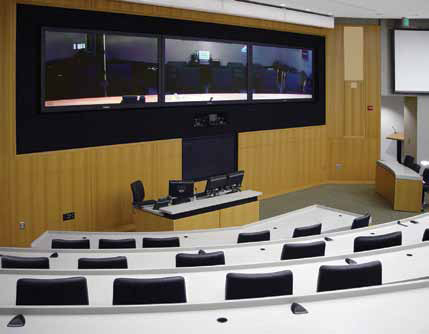IVCi Designs Virtual Lecture Hall For Duke University’s Fuqua School Of Business
IVCi integrated a Cisco TelePresence solution in a lecture hall at Duke University’s Fuqua School of Business, designing the system to accommodate the 140-seat space.
DURHAM, NC—To prepare students for today’s global business environment, Duke University’s Fuqua School of Business’ curriculum includes material and lectures by subject matter experts who include distinguished professors, business leaders, and guest lecturers. In the past, arranging for these experts to speak to classes was often challenging, as it could sometimes take two to three business days for a guest to travel to the campus and deliver a presentation. “We needed a more efficient way to provide students with the opportunity to interact with some of the world’s leading business decision makers,” said Duke’s technical project manager Tom Freeland.
The Fuqua School of Business turned to advanced technology, choosing to pioneer the use of Cisco TelePresence in higher education by installing a system in one of its lecture halls. TelePresence is a natural choice for the classroom environment, where live interaction between lecturer and student is critical to successful learning. “This technology was chosen because of the extreme high quality of the calls,” Freeland said. “There is very little latency with the Cisco system, and its performance is far superior to traditional video conferencing.” In addition, Duke has a large infrastructure that is based on Cisco technology.
Duke chose IVCi to design and install the TelePresence system in a traditional classroom with stadiumstyle seating for up to 140 people. IVCi designed the system to accommodate a larger audience size than traditional TelePresence systems, while still maintaining the authentic TelePresence experience.
“When we started there were just two projectors in front of the room, and the instructor would use a PC or document camera to project onto the screen,” said Timothy Hennen, IVCi’s SVP of audiovisual integration. “The TelePresence integration created a new mode of operations— Duke instructors and subject matter experts are now able to share ideas and content through their PCs or document cameras with local and remote students.”
The lecture hall includes three Panasonic TH-103PF12UK 103- inch plasma displays, mounted on a custom-built wall designed to bear the weight of the equipment, three Sony EVI HD7V 1080p cameras, and three Cisco TelePresence 1080p cameras for both panoramic and life-size immersive video experiences. An additional three Panasonic TH-32LRT12U displays allow the instructor to view remote classrooms from the podium.
The instructor’s podium was outfitted with two Wolfvision VZ-C12 document cameras for sharing class material. A ‘TelePresence’ mode was added to an existing Crestron touchpanel for access to the system. “We programmed an existing Crestron control system so that it would be easy for anyone to pick up and use it for TelePresence calls,” Hennen said. “TelePresence mode allows the user to select multiple content sources to be shared locally and with the remote site. In addition, we created simplified scenarios for the camera and monitor, which are based on class size and instructor location.”
Sixty-six Shure MX329/C custom push-to-talk microphones were installed and configured to trigger cameras to zoom in and capture a life-size view of the speaker. “Video processors were used to change from the fixed Cisco panoramic cameras to the feature cameras based on the scenario’s rules sets,” Hennen elaborated. “All camera movement was hidden from view. Camera switching occurs only when the feature cameras are locked in place, emulating the audio segment switch technology inherent to the Cisco codec.”










